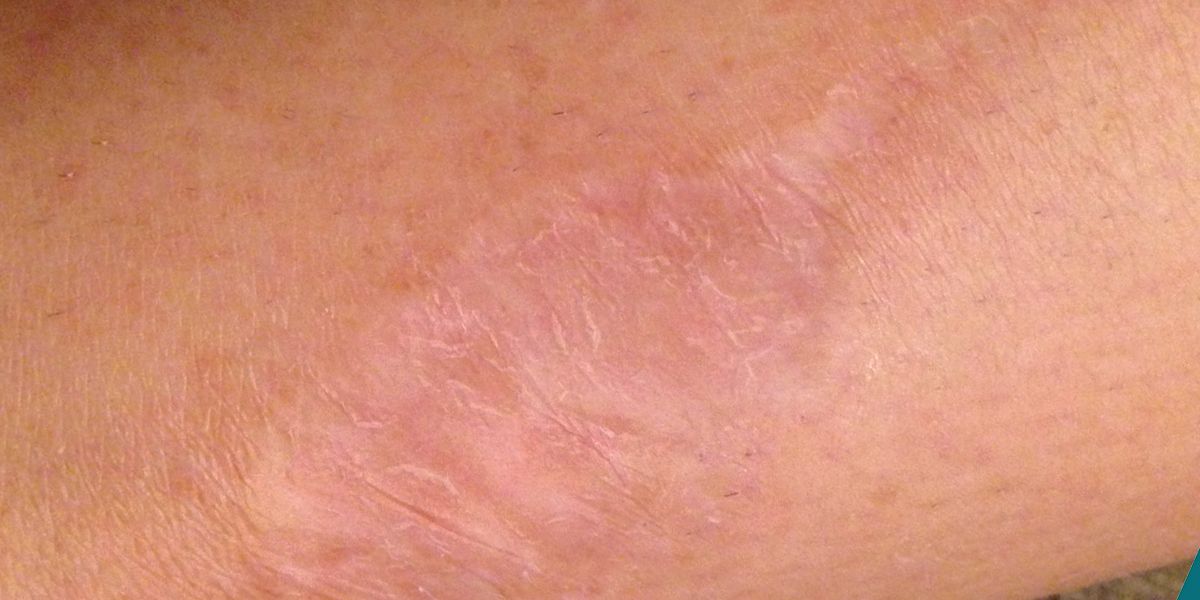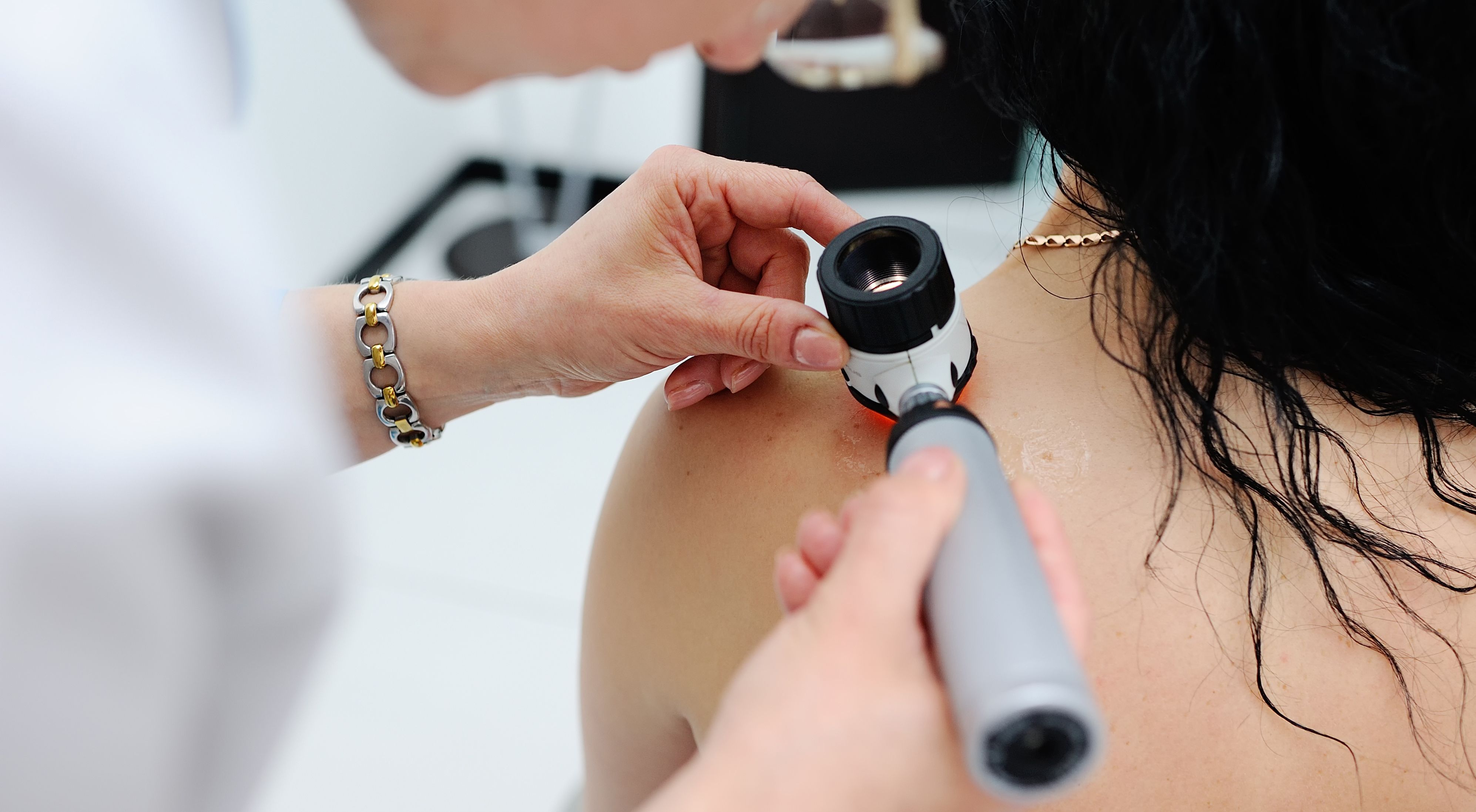Article
Keeping Up Appearances: Minimizing Scarring After Skin Cancer Surgery
Author(s):
During and after surgery for skin cancer, a number of strategies can help minimize scarring.
My advice to anyone who needs surgery but wants to minimize the long-term impact on their looks is, first, to find a really well-regarded surgeon and, second, to follow post-surgical instructions to the letter.” <br> — JENNIFER POLLOCK, patient - PHOTO BY LAURA SCHMIDT

My advice to anyone who needs surgery but wants to minimize the long-term impact on their looks is, first, to find a really well-regarded surgeon and, second, to follow post-surgical instructions to the letter.”
— JENNIFER POLLOCK, patient - PHOTO BY LAURA SCHMIDT
Jennifer Pollock entered her dermatologist’s office in search of cosmetic improvement and exited in fear of disfiguring surgery. The faint dot under her right nostril, the one she had hoped to vanquish with some lotion, was a basal cell carcinoma (BCC) that needed to come out.
Pollock underwent Mohs surgery, in which thin layers of skin are removed until no cancerous tissue remains, and lost a teaspoon’s worth of flesh before her doctor began the delicate reconstruction. He made small cuts in the surrounding muscle and fatty tissue and used 45 stiches to pull it together. Then he used another 50 stiches to reconnect the skin, right along a natural wrinkle that would hide the tiny scar.
“I worried after that initial diagnosis that my scar would always be the first thing people noticed about me … I was so nervous that, when the doctor advised against talking for a day or two after the procedure, I went a whole week without speaking. I bought a small white board and carried it with me,” says Pollock.
Her diligence paid off. Virtually no trace of her surgery remains.
“My advice to anyone who needs surgery but wants to minimize the long-term impact on their looks is, first, to find a really qualified surgeon and, second, to follow post-surgical instructions to the letter,” says Pollock, who lives in Dana Point, California. “It’s crazy to find a real expert and then ignore that expert’s post-op instructions.”
Pollock, who had her surgery five years ago, when she was 35, is younger than most BCC patients, but otherwise, her story is extremely common. Americans undergo more than 5 million skin cancer surgeries every year, most for BCC, and a large number involve body parts that are exposed to both the sun’s rays and the public’s view.
The good news is that the overwhelming majority of those surgeries eliminate the underlying cancer. Dermatologists diagnose more than 4 million BCCs a year, but the annual death toll from such cancers is under 3,000. Surgery also eliminates most cases of squamous cell carcinomas and even melanomas, which represent just 1 percent of all skin cancers yet cause the most skin cancer deaths.
The bad news about surgery is that it can be disfiguring, particularly when cancers occur on the head, neck and lower arms. Every surgery produces a permanent scar, and those that involve significant tissue loss can alter appearance.
Even the best doctors and the most diligent post-op care cannot always hide the traces of surgery, but they can minimize the risk of disfigurement, both during the initial procedure and, if such a surgery heals badly, in the months and years that follow. Both Medicare and private insurers, moreover, typically cover most aesthetic reconstruction as part of cancer care, rather than classifying it as elective work that patients must finance on their own.
“I have been doing this for many years now, and I don’t think I’ve ever had any insurance company refuse a patient’s claim, either for reconstructive work I’ve done immediately after tumor removal or for procedures designed to fix scars that have healed poorly,” says Evan Matros, M.D., a plastic surgeon at Memorial Sloan Kettering Cancer Center in New York.
“Scars and disfiguration can seriously reduce quality of life. Minimizing them is part of proper cancer care, which is why getting coverage should not be an issue in most cases.”
Initial Treatment for Skin Cancers
Small and superficial cases of non-melanoma skin cancer are sometimes removed without any surgery. Physicians might simply scrape them away, prescribe chemotherapy creams or zap them with lasers or radiation.
For people with larger BCCs or squamous cell carcinomas (SCCs), non-surgical options still exist. Superficial radiation therapy and electron-beam radiation can be used on most non-melanoma skin cancer, but treatment can require up to 20 visits, long-term cure rates are not fully established, the aesthetic advantages are debatable and only a few hundred dermatologists nationwide offer such procedures. Most patients, in other words, will end up undergoing surgery. Surgery is the standard firstline treatment for melanoma, as well.
There are two basic strategies for the surgical removal of skin cancer. Standard surgical excision removes any visible tumor plus an extra 3 to 10 millimeters of surrounding flesh before samples go to the lab to ensure that the tissue at the edges of what was removed (the margin) is normal. Mohs surgery removes almost nothing but the visible part of the tumor, but margin analysis takes place while patients wait, so doctors can keep on removing extra slices until those edges are cancer-free. Mohs surgery can be used in melanoma, particularly on the face, but is not always as appropriate in that disease as in other forms of skin cancer, according to the American Cancer Society.
Mohs surgery has a higher initial cure rate in basal and squamous cell cancers than does standard excision — more than 99 percent for newly diagnosed cancers — because patients don’t leave until tests show that all the cancer is gone. Still, more than 95 percent of these cancers can be cured with standard excision, and when cancer remains after that type of surgery, patients can undergo a second procedure. Therefore, in terms of protecting patients from cancer, the two types of surgery are roughly equivalent. The real differences involve time, money and aesthetics.
A Mohs surgery often involves several surgical sessions and several tissue analyses, each performed about an hour apart because every slice must be frozen before examination. Those multiple procedures typically remove less tissue than standard excisions and typically have less visually apparent impact on patients. Unfortunately, they also tend to require more labor expertise than a single big cut and a single analysis, so providers typically bill more for Mohs surgery. (When insurers cover Mohs, which they usually do in cosmetically sensitive places like the face, patients do not contend with higher bills. Insurers don’t necessarily cover Mohs as an initial treatment on all parts of the body if the cancer isn’t aggressive or recurrent, though.)
The most appropriate strategy for putting patients back together after either type of surgery varies with the amount of tissue removed, the location of the surgical site and the unique traits of each patient. In general, surgeons follow an algorithm called the reconstructive ladder, which lists their options in order of increasing complexity, starting with natural healing, and advocates the simplest workable technique.
Natural healing, which doesn’t even involve stitches, beats reconstruction for many small wound locations like the bowl of the ear or top of the scalp. Soft tissue around the wound naturally contracts and closes in a way that can create less visible scarring than stitches after very minor surgery.
If the wound is too big to heal well on its own, the surgeon moves to the next simplest procedure: using stitches to pull the wound together and fill the space vacated by the missing cancer. Depending upon how deep the cancer had grown, this might involve a single layer of surface stitches or several tiers of stiches, each on top of the other, to ensure that the underlying muscle and fat grow together properly.
Stitches may hardly seem to justify the term “surgical reconstruction,” but surgical skill greatly influences cosmetic outcomes.
For example, the location of the first stitch determines whether the skin is pulled together from the top, from the side or from an angle. Pulling skin from a slack area rather than a taught one decreases pressure on the closure and reduces the size of the scar. The direction of the stitching can also determine whether the scar hides inside (or at least parallel to) natural lines or whether it calls attention to itself by running perpendicular to those lines.
Attaining the Best Cosmetic Results
The skill of the surgeon is not the only factor in the eventual outcome, however. The idiosyncrasies of each patient’s skin — its coloring, thickness, elasticity and ability to heal itself — probably play an even larger role.
“If two patients come in for the same procedure on the same day and the surgeon does exactly the same quality work on both of them, it’s entirely possible that, after a year passes, the scars will appear differently,” says Joseph F. Sobanko, M.D., director of dermatological surgery education at the Hospital of the University of Pennsylvania.
“Patients with fairer skin may produce scars that may maintain a persistent redness, but there are a lot of factors at play. Wounds that are located on high-tension sites, and such as the back and chest, pull at stitches, and can create scars that are more visible than on low-tension areas, such as the face.”
If a wound is so large that it’s impossible to pull it shut without overstressing the surrounding tissue, the surgeon must either take flesh from another part of the body and graft it onto the surgery site or cut into surrounding skin (without cutting it off) and attach it to the surgery site.
A skin graft is oddly comparable to a strip of sod. It grows elsewhere, only to be peeled off and moved to a new location, where it soon lays down new roots (i.e., blood vessels). If the surgeon can harvest the graft from near the surgery site, a skin graft can heal to near invisibility. Unfortunately, it’s hard to find extra skin on the head and neck, so surgeons generally must use skin from elsewhere, which differs in both texture and color and never looks entirely right.
For this reason, the best cosmetic results frequently come when surgeons perform an adjacent tissue transfer or a flap reconstruction. To do this, they borrow tissue from neighboring sites by cutting through the skin and soft tissue on all but one side, rotating it and using it to fill the surgical defect. The skin stays connected to its original location one side, so it maintains blood flow and heals faster.
This technique is commonly used to cover a surgery on the bottom of the nose (a hard place to stretch existing skin) by cutting a lollipop-shaped flap off the forehead, sewing the bulb of the lollipop to the surgical defect under the nose and leaving the rest as a bloodsupplying bridge of skin over the upper part of the nose for roughly three weeks. It’s more delicate and cumbersome than a skin graft while healing — and it can make wearing glasses very challenging — but after a second surgery removes the skin bridge and everything heals, the surgery consistently produces good results.
“Every procedure is different. You have to ask yourself what, exactly, was removed and where on the body you can find the most similar material to replace it. You have to design and execute a plan to move the tissue into the surgical defect while not creating new problems through the repair and healing process. It takes time to develop both the surgical skills and a feel for how the body will heal itself, but a skilled and experienced surgeon typically produces pretty impressive results,” says Andrew Kaufman, M.D., medical director of The Center for Dermatology Care in Thousand Oaks, California, and a clinical associate professor of medicine at USC’s Keck School of Medicine.
Refining Results
The topic of post-surgical care evokes far more disagreement among physicians than the topic of proper reconstructive technique. Everyone agrees that patients who want the best cosmetic results must keep themselves clean enough to prevent infection, avoid activity that could tear the stitches and not expose the scar to UV radiation for a year after surgery.
Almost everything else is up for debate. There’s very little published research on how patients can minimize scars, so doctors use anecdotal evidence to make recommendations. Some physicians swear by vitamin E, silicone gel or other products. Others swear that all such products are costly placebos. Fortunately, there’s widespread agreement that patients who initially fail to get the desired cosmetic results have options for improvement.
Dermatologists can sand scars down with dermabrasion, resurface them with lasers, inject bulges with steroids or, as a last result, cut scars off and try again — and insurers will often cover such procedures. Better still, most patients never ask for such procedures because they’re satisfied with their outcomes.
Less than 5 percent of all patients ever go so far as to ask about any such follow-up, Kaufman says. Even those patients who are initially disappointed by their results sometimes find that cosmetic outcomes are less important than they had imagined.
Things that seem terrible at first just don’t seem that bad after you’ve had time to get some perspective.” <br> — KENZIE MORSE, patient - PHOTO BY JENNA LEIGH PHOTOGRAPHY

Things that seem terrible at first just don’t seem that bad after you’ve had time to get some perspective.”
— KENZIE MORSE, patient - PHOTO BY JENNA LEIGH PHOTOGRAPHY
Kenzie Morse, of the Cayman Islands, decided against getting a skin graft to cover the site of a melanoma surgery she underwent on her ankle a couple of years ago. Her doctor had not expected to find much cancer in a 16-year-old patient, but the tumor turned out to be bigger than a golf ball, and the procedure produced some highly visible marking. As a rule, younger patients worry more about their appearance than older ones, and Morse has more reason for concern than almost anyone else: She makes her living as a model. Nonetheless, she has long since stopped being selfconscious about her wound and doubts she’ll ever take any steps to make it look better.
Morse wishes she had opted for a skin graft, but has learned to accept her scar.

Morse wishes she had opted for a skin graft, but has learned to accept her scar.
“I wish I had chosen originally to go with the graft and take better care of it, because it turned out pretty gruesome,” she says. “But it just hasn’t mattered as much as I once feared. Things that seem terrible at first just don’t seem that bad after you’ve had time to get some perspective.”




